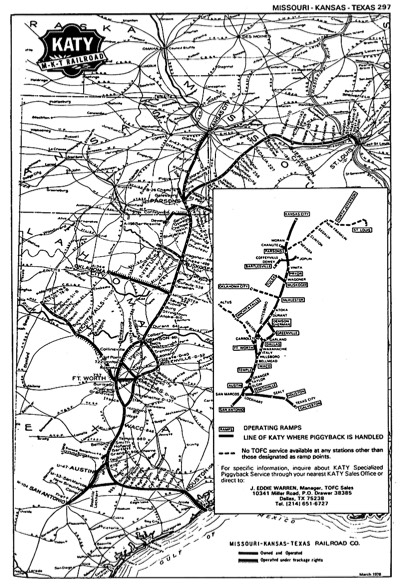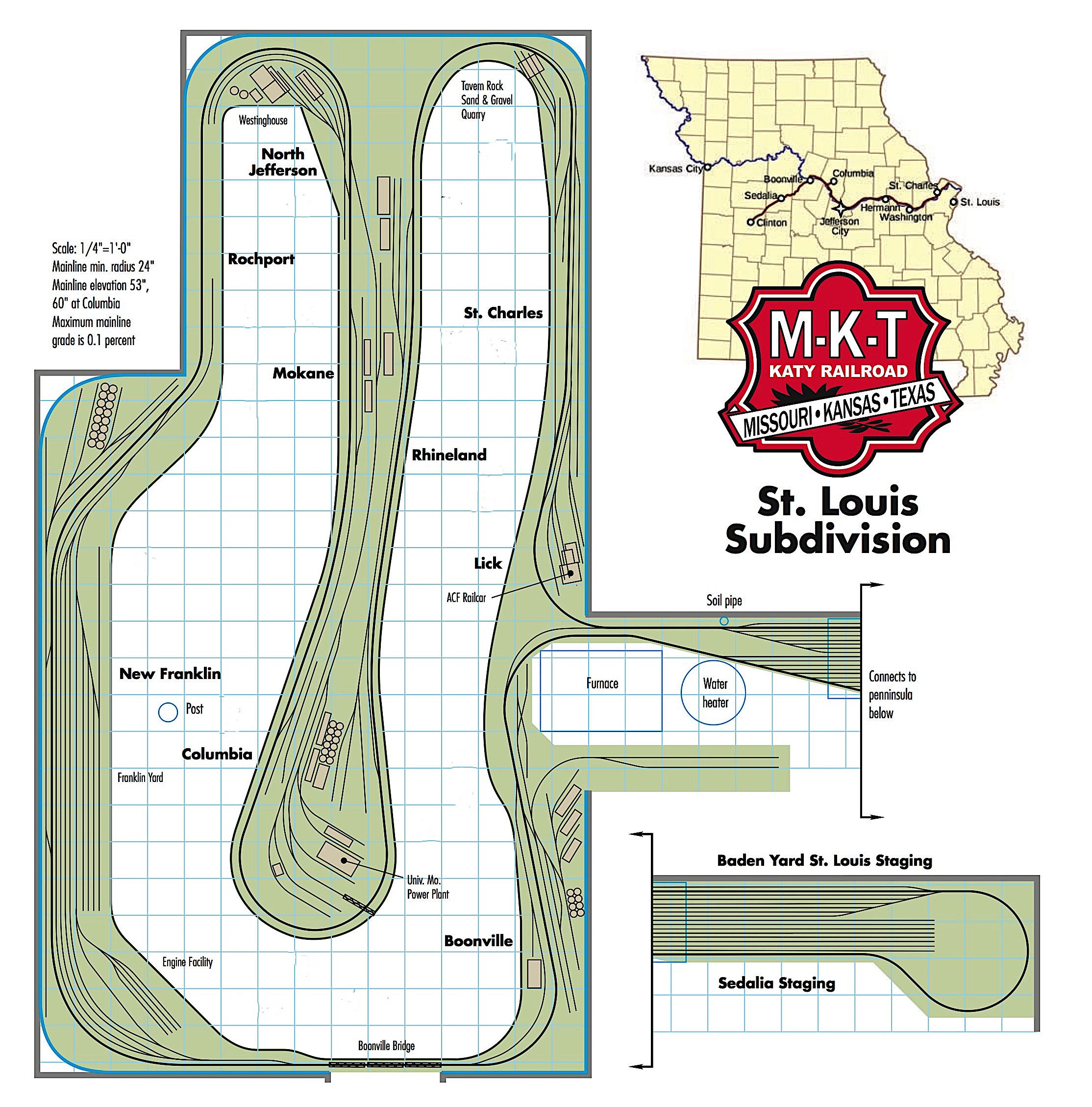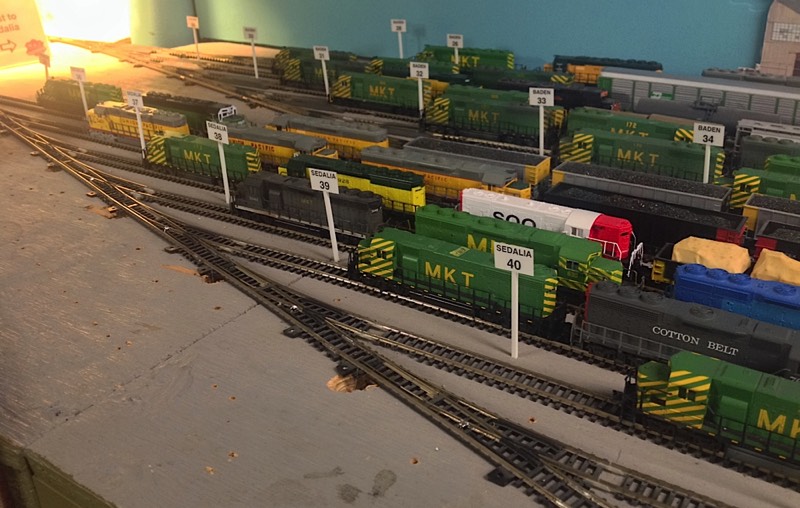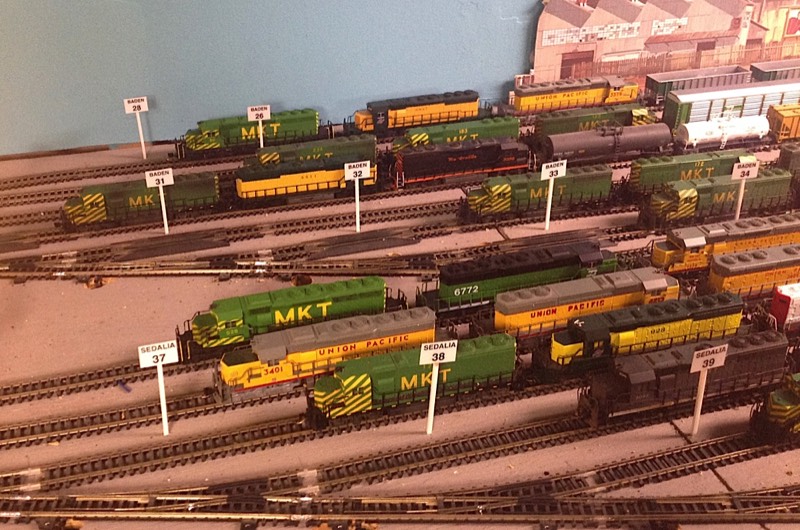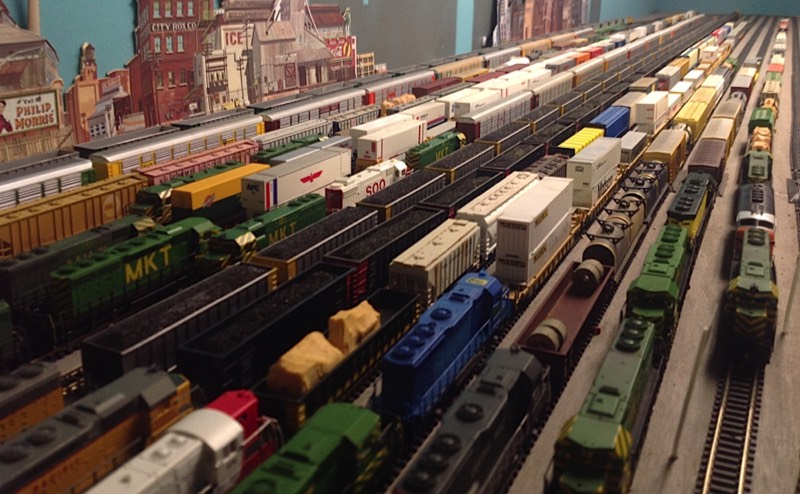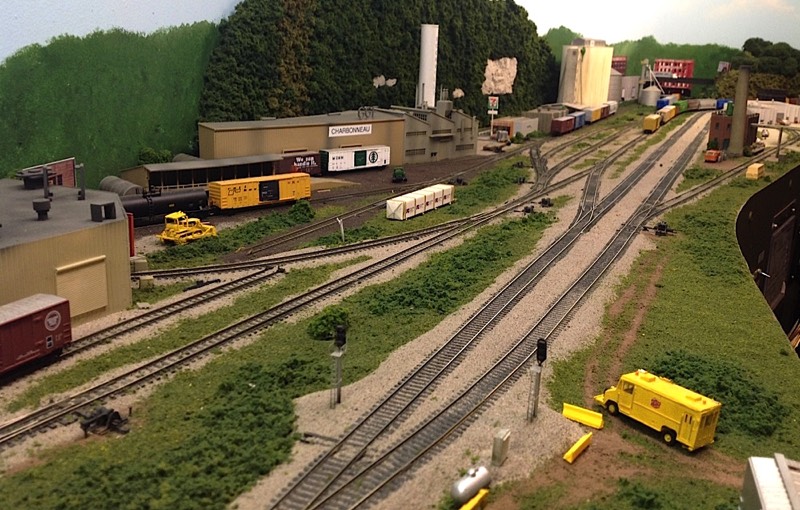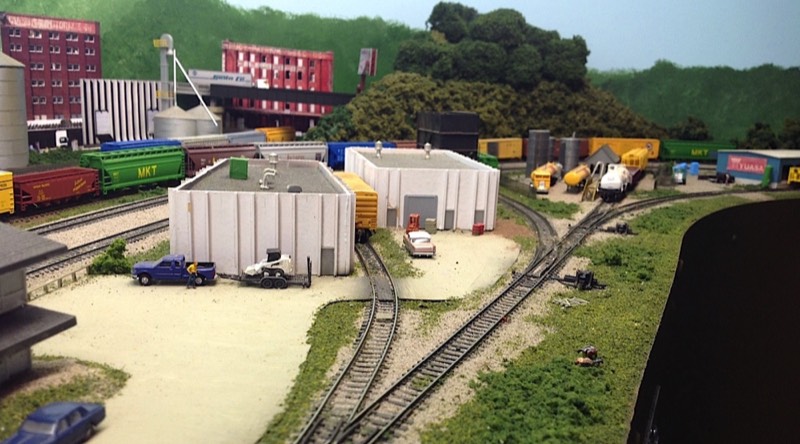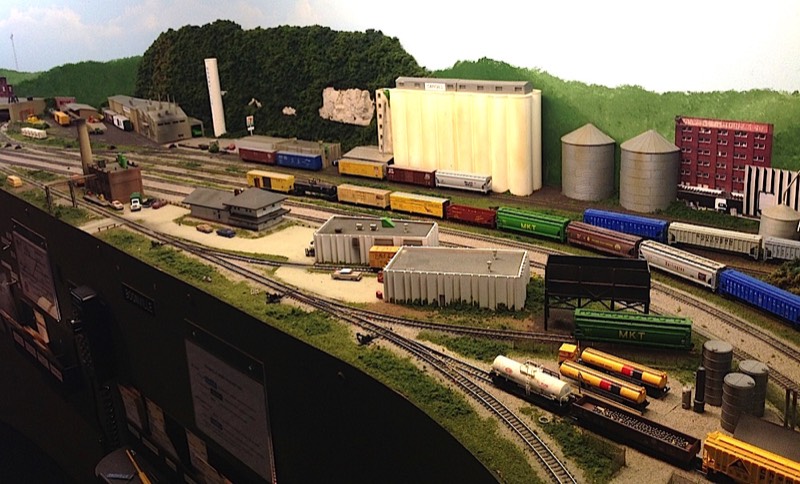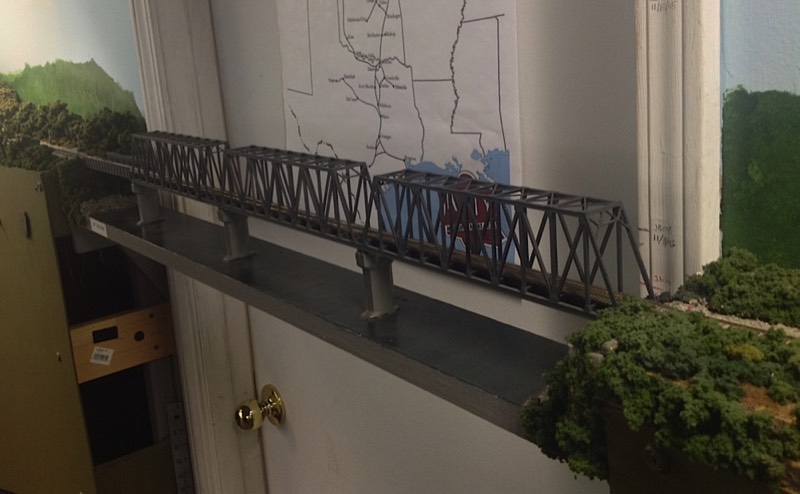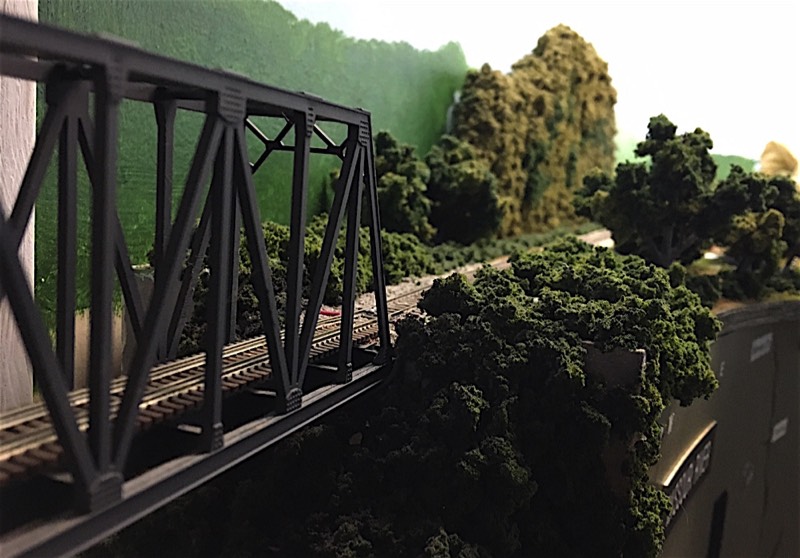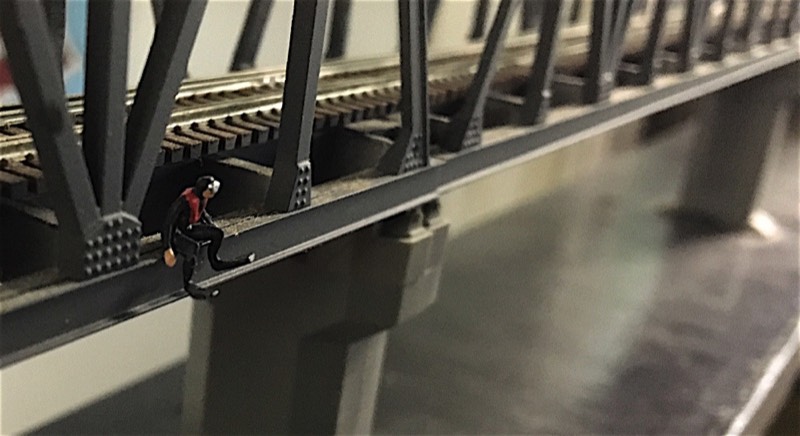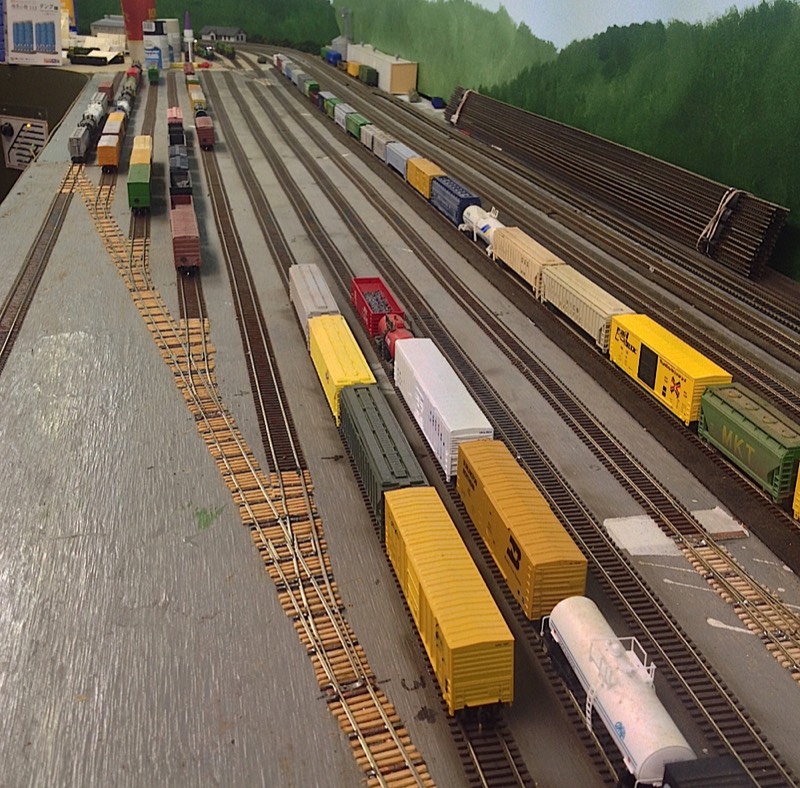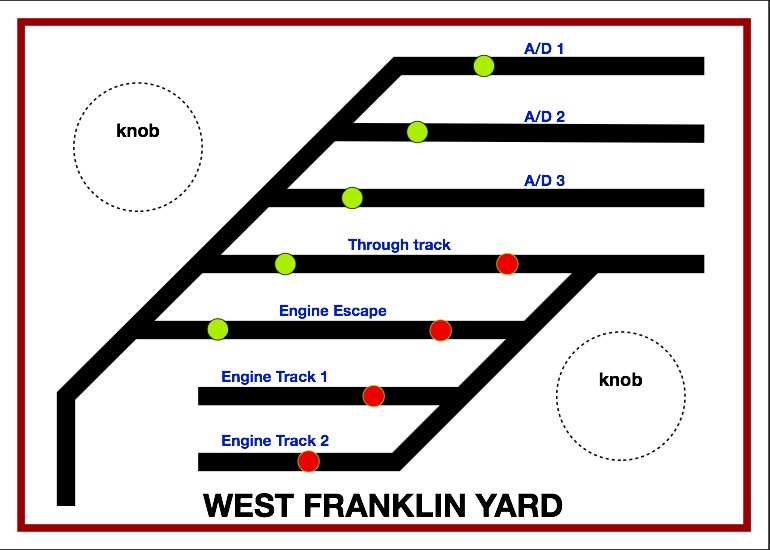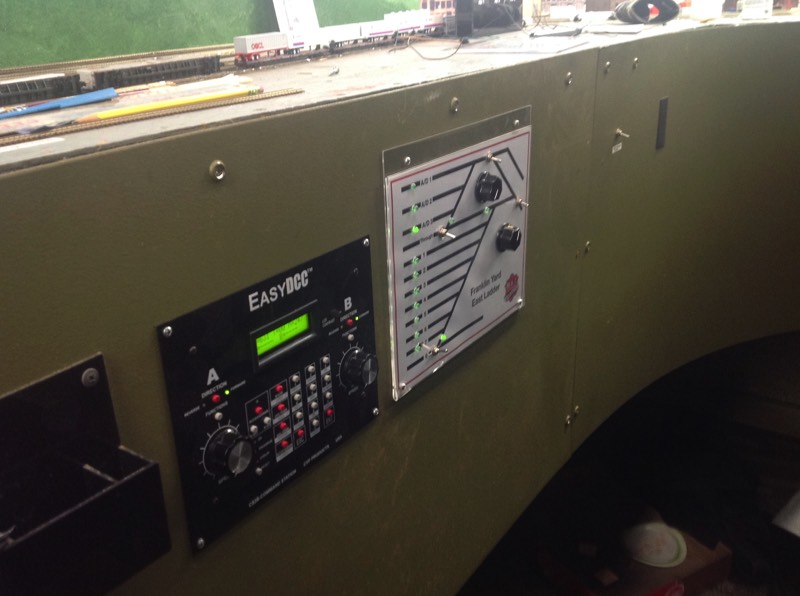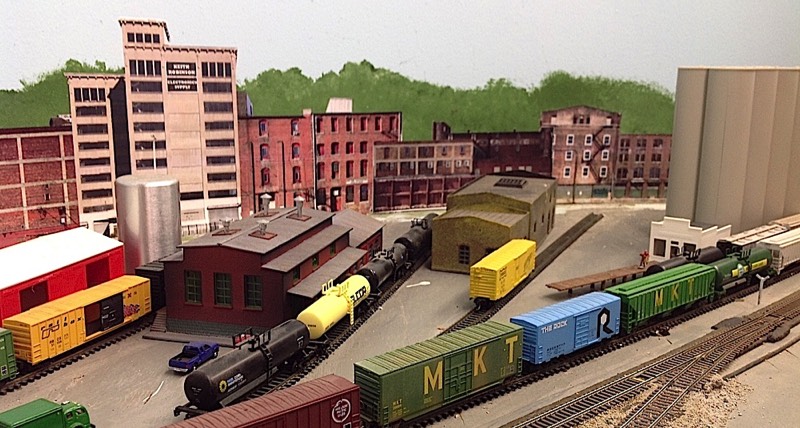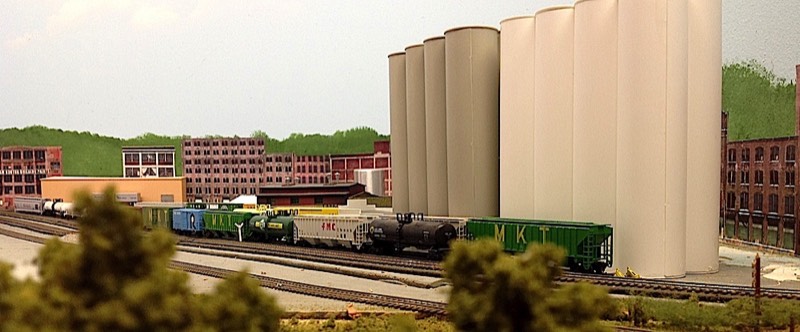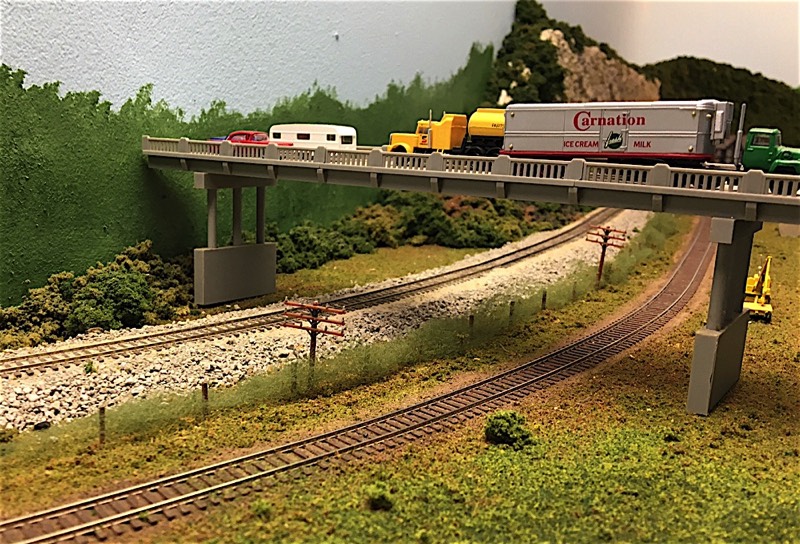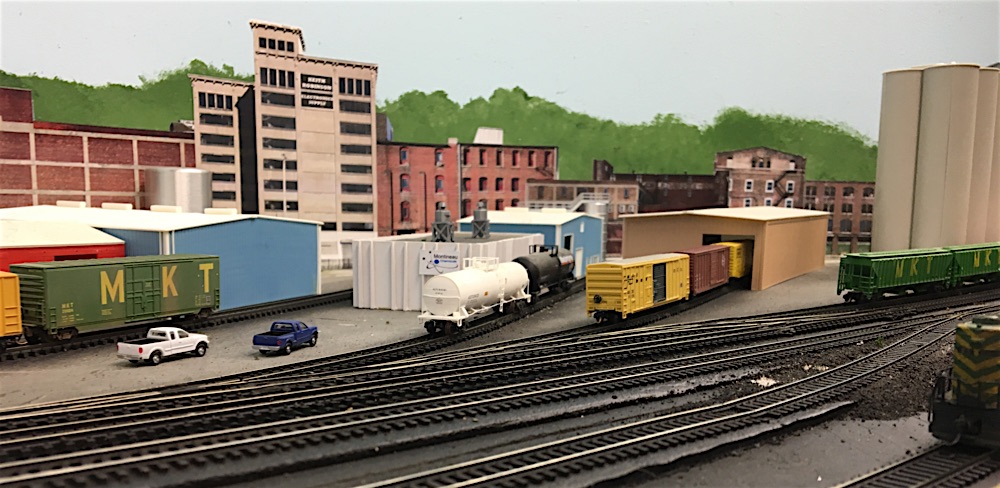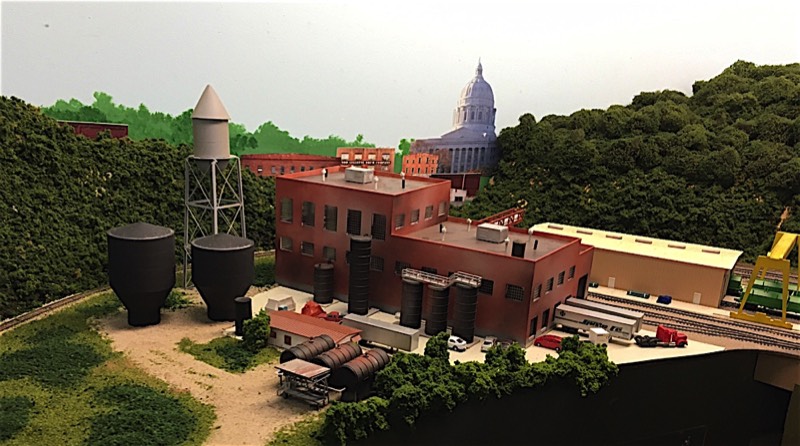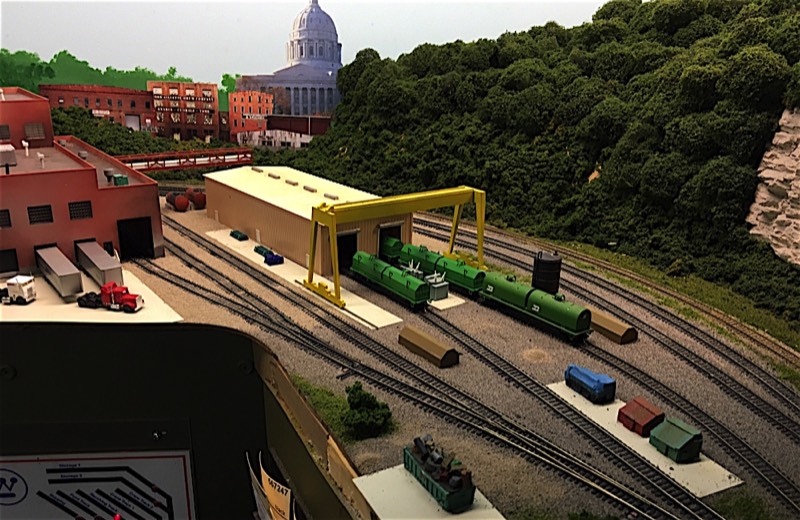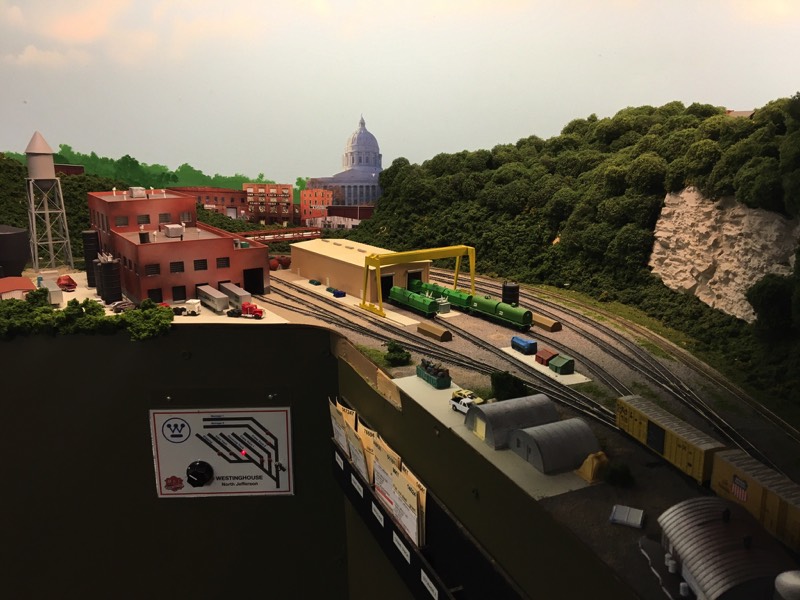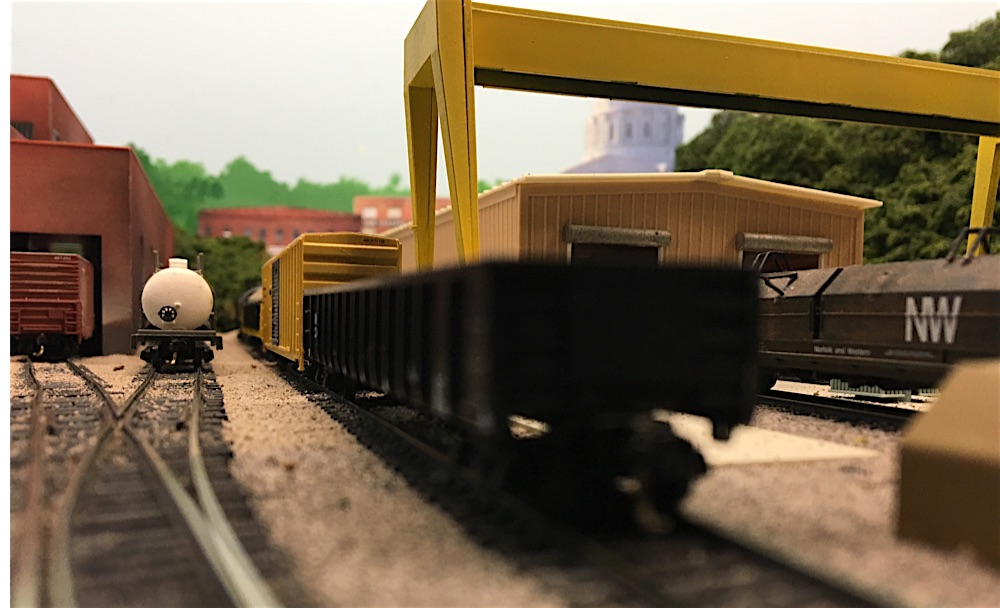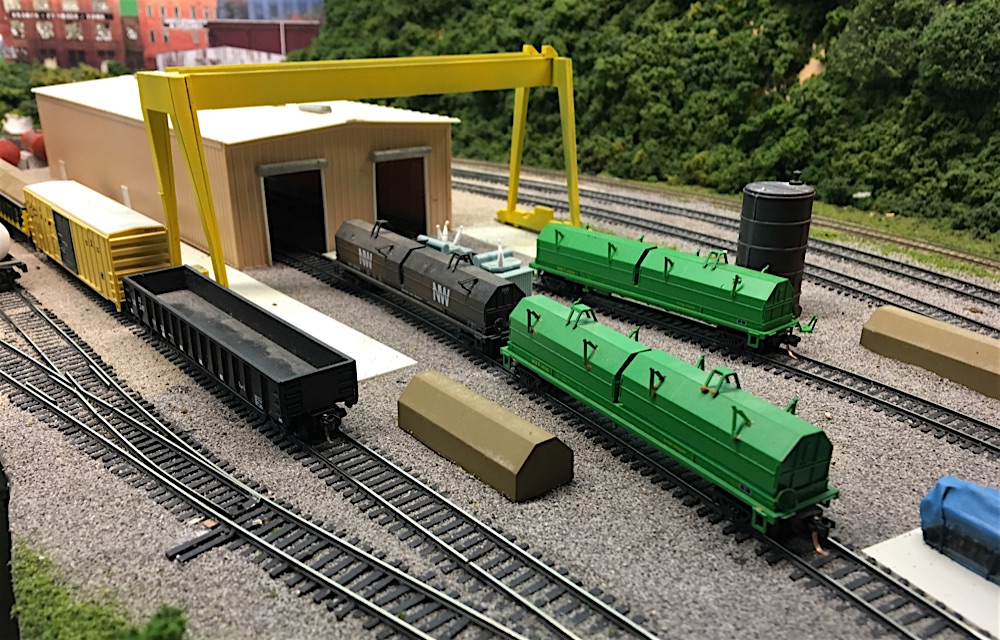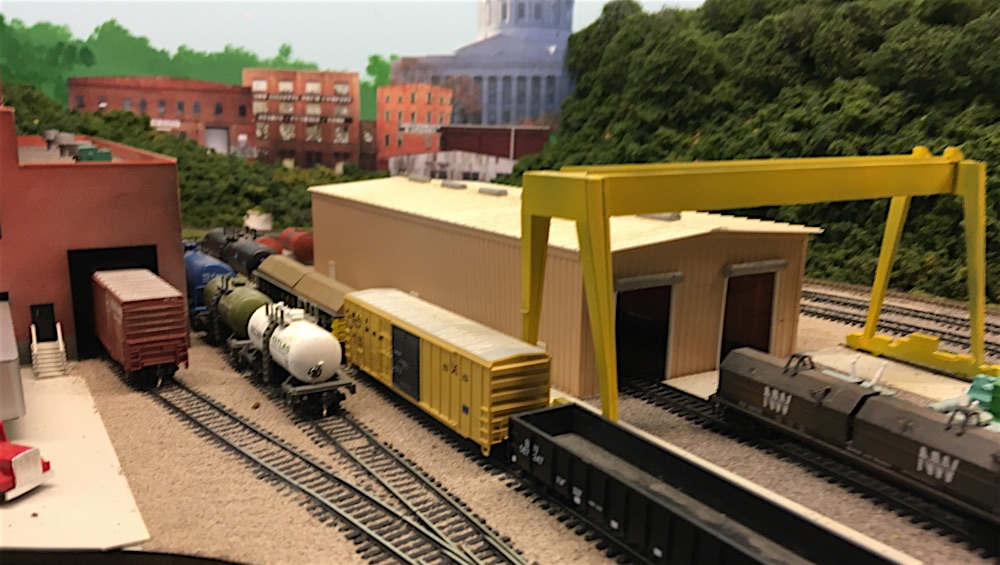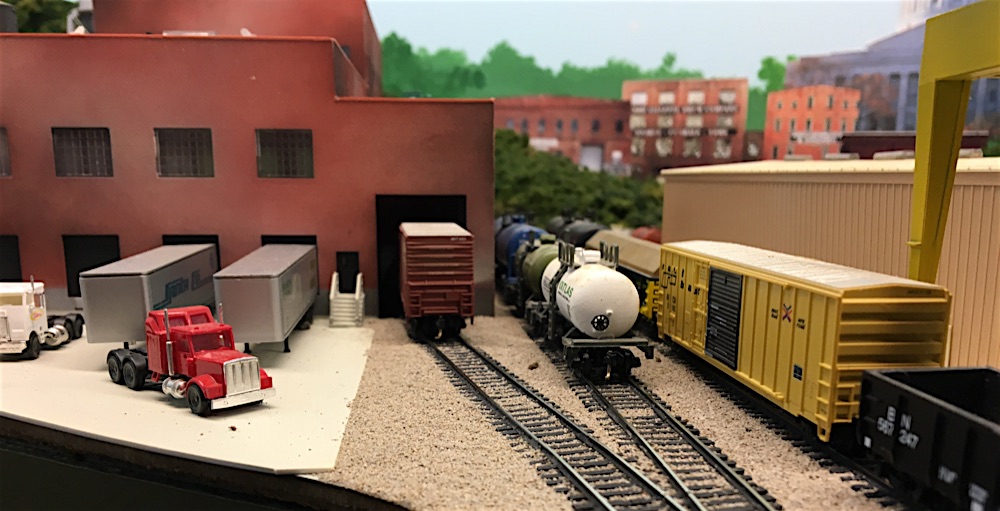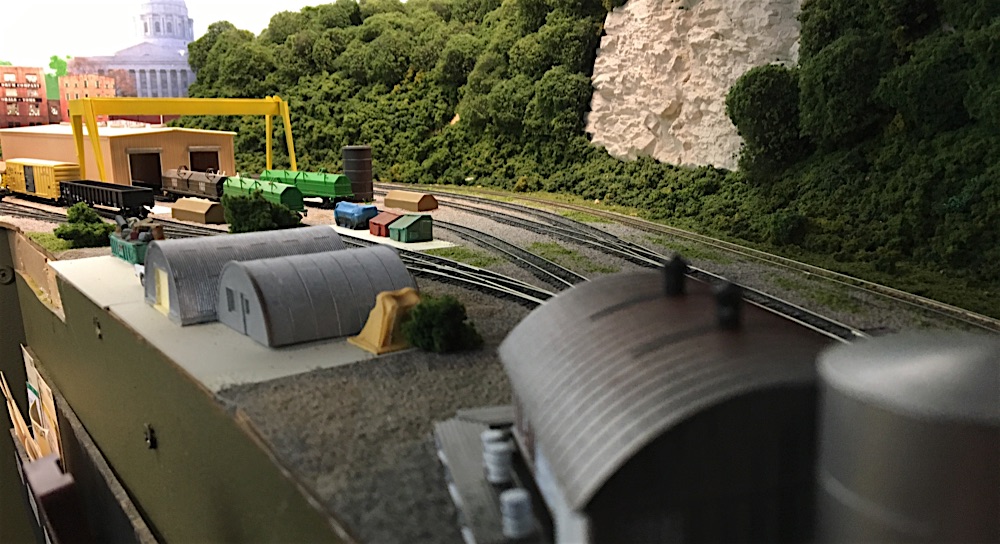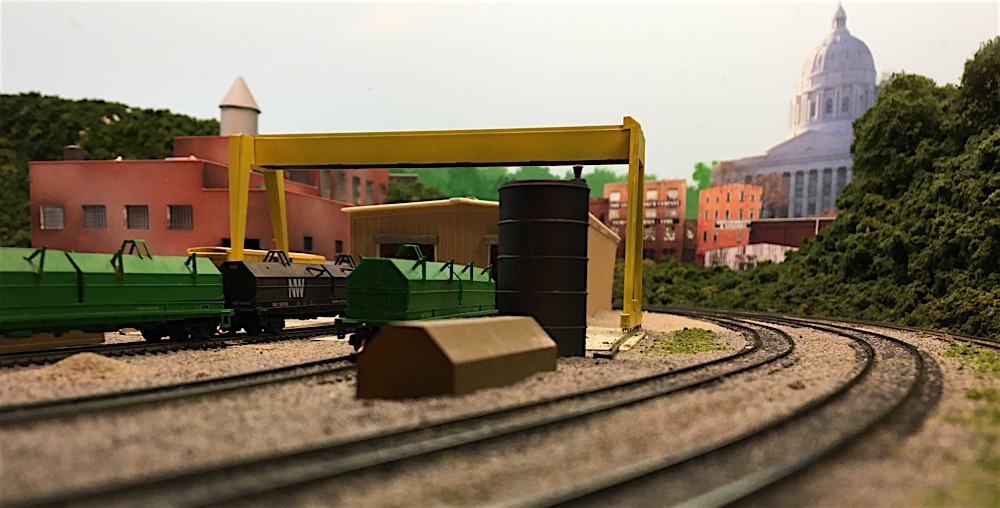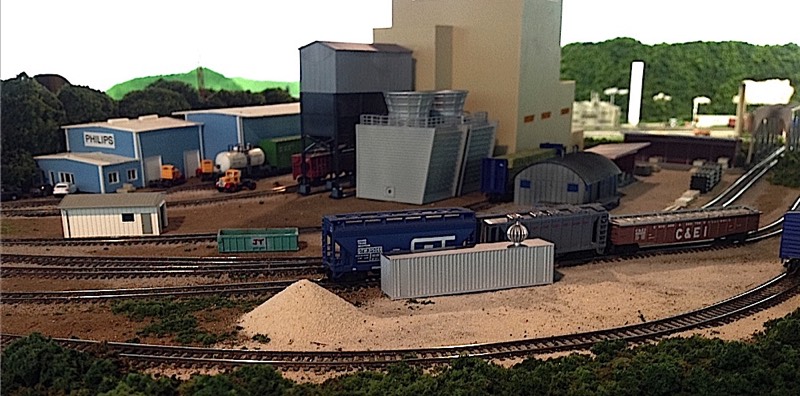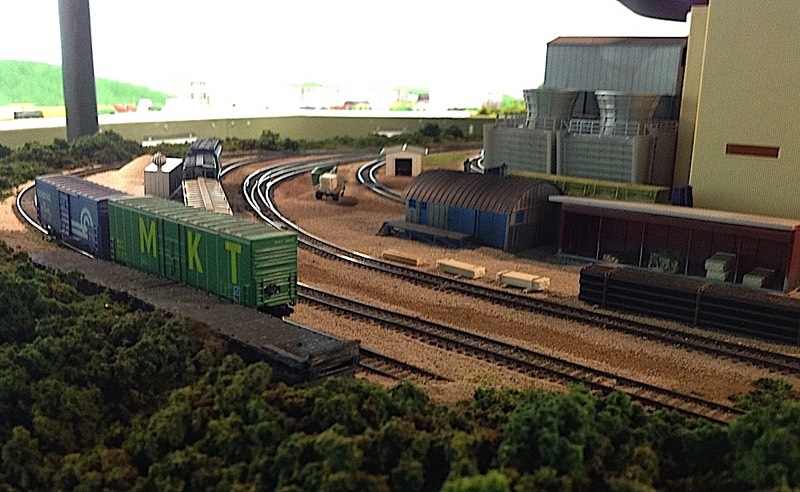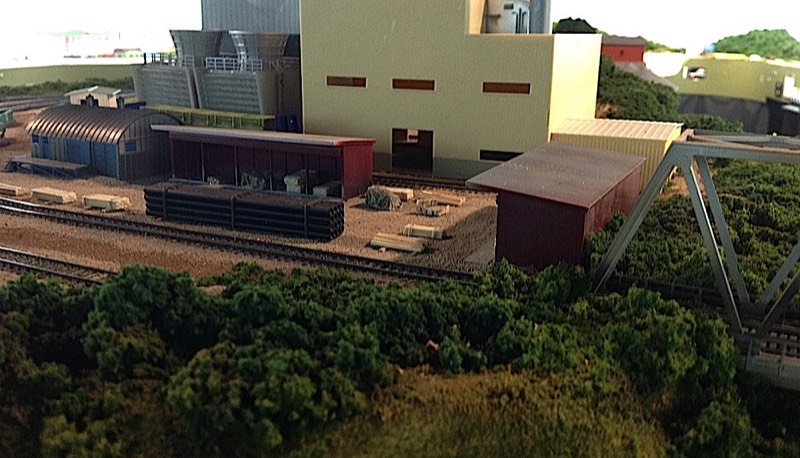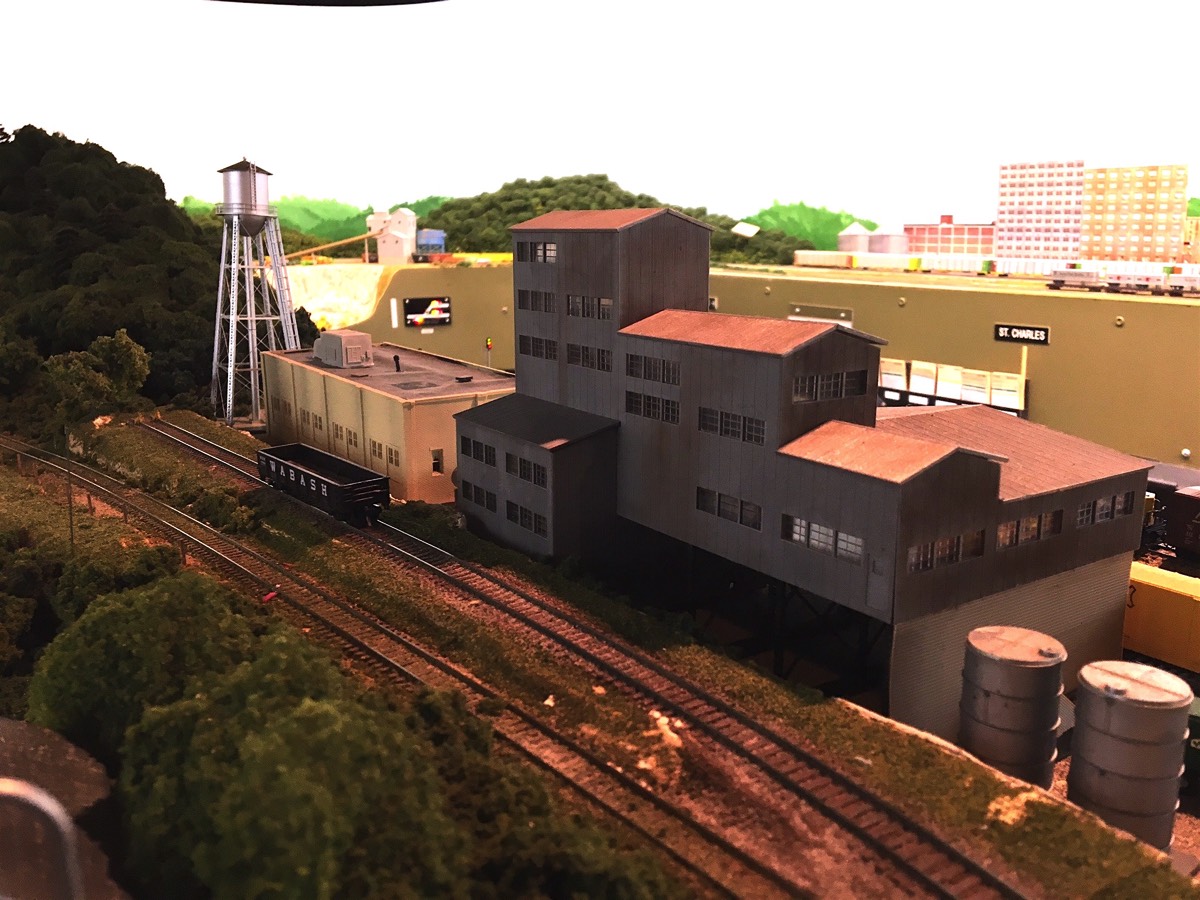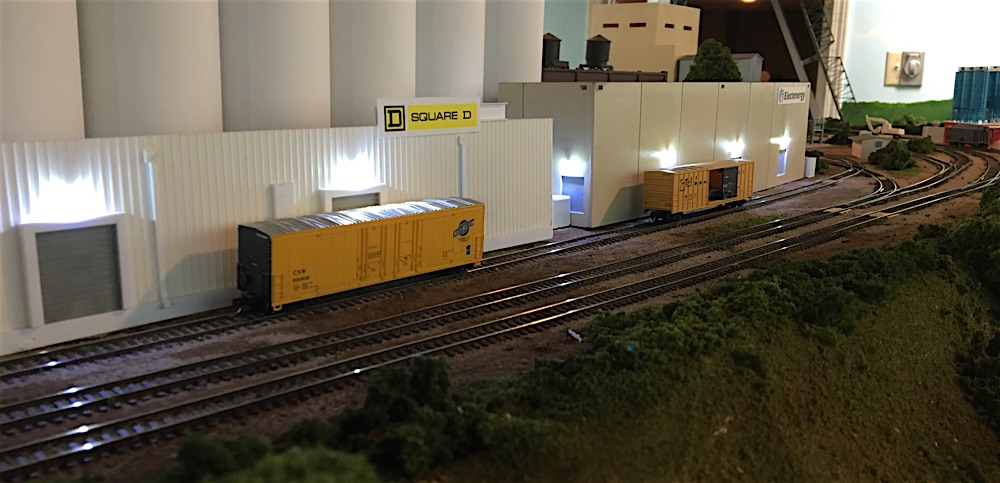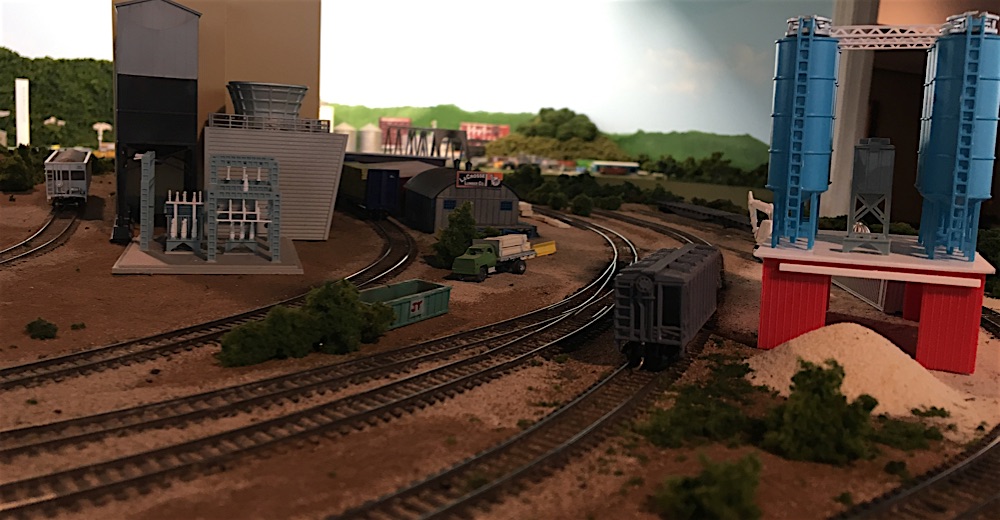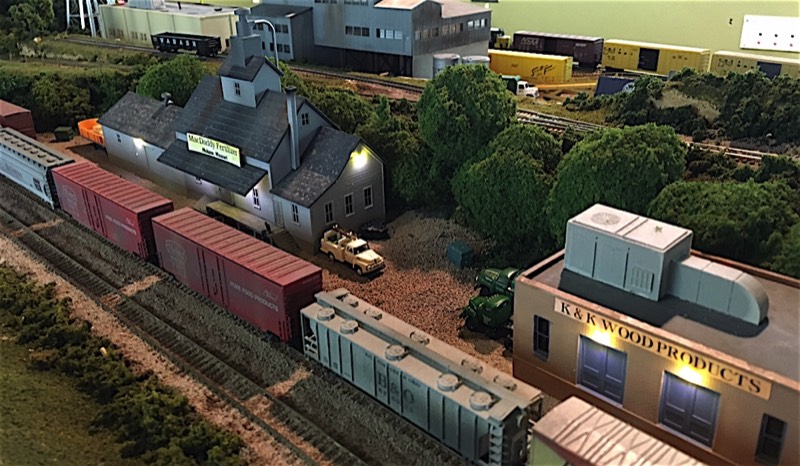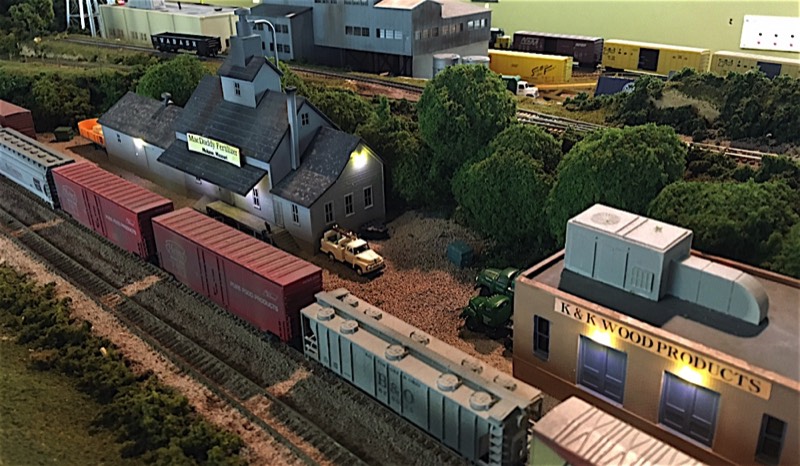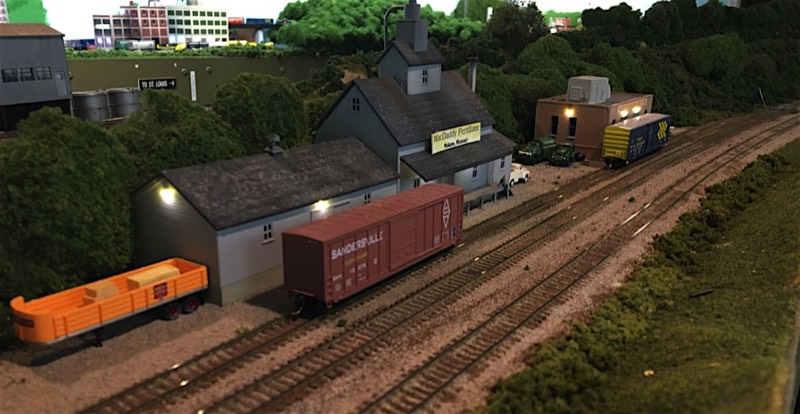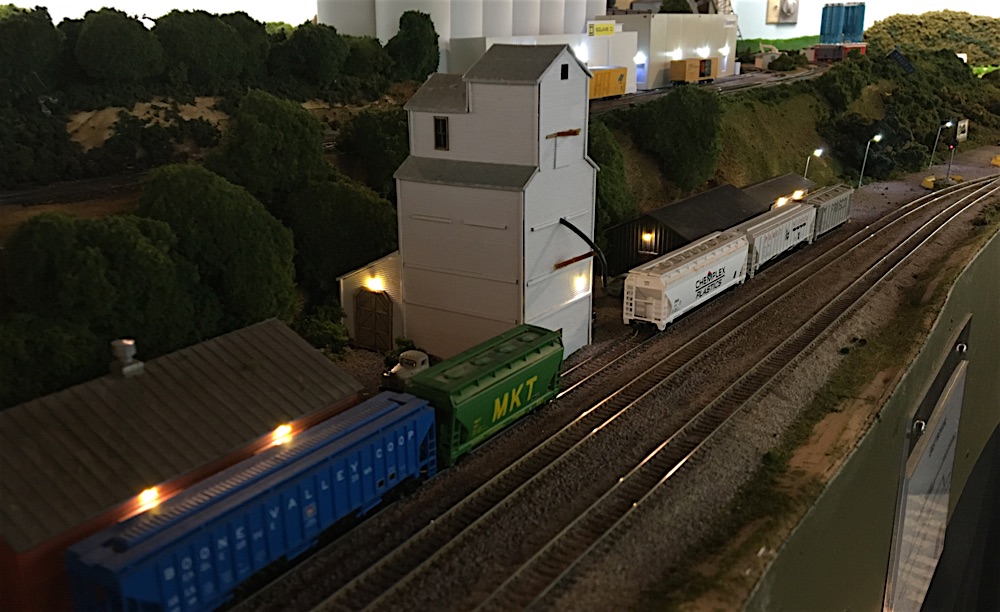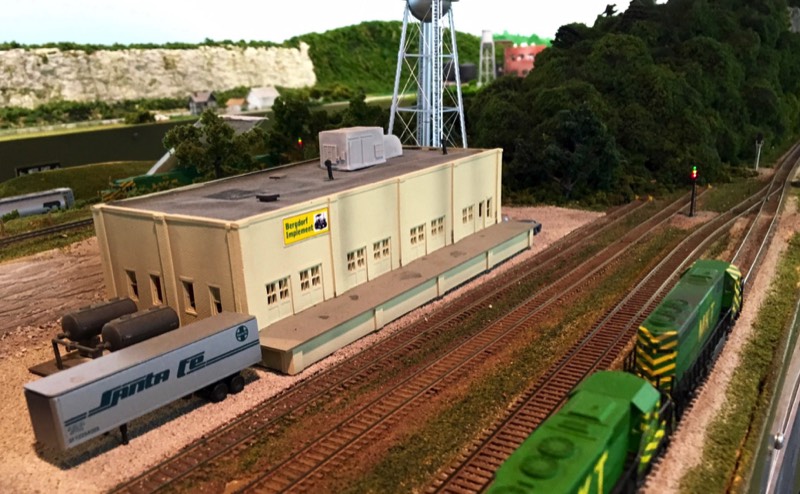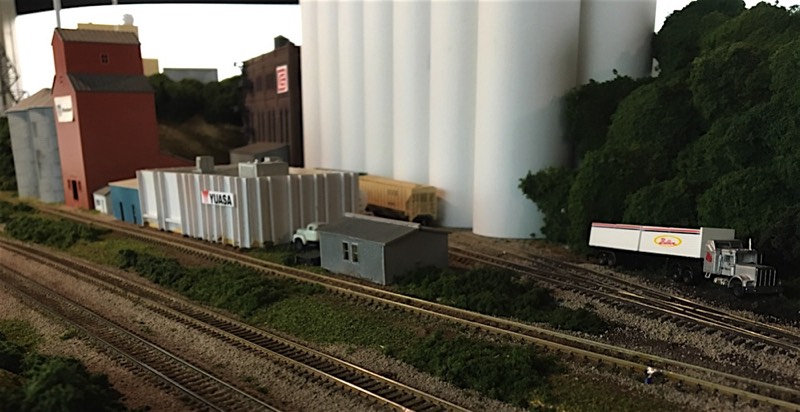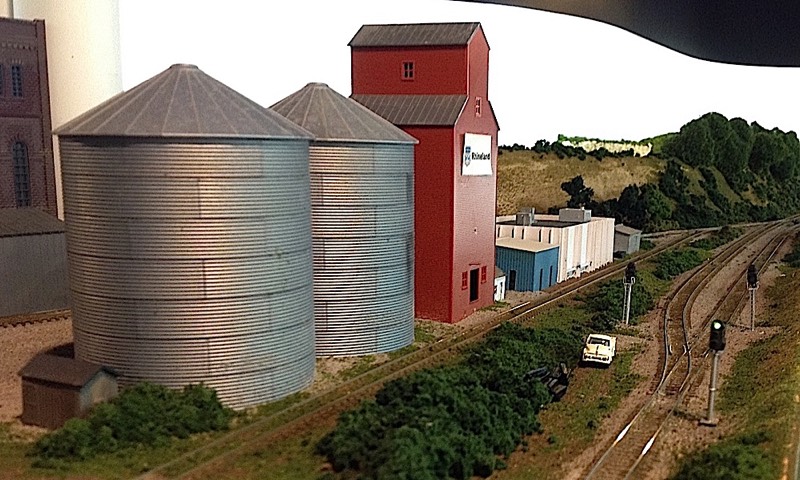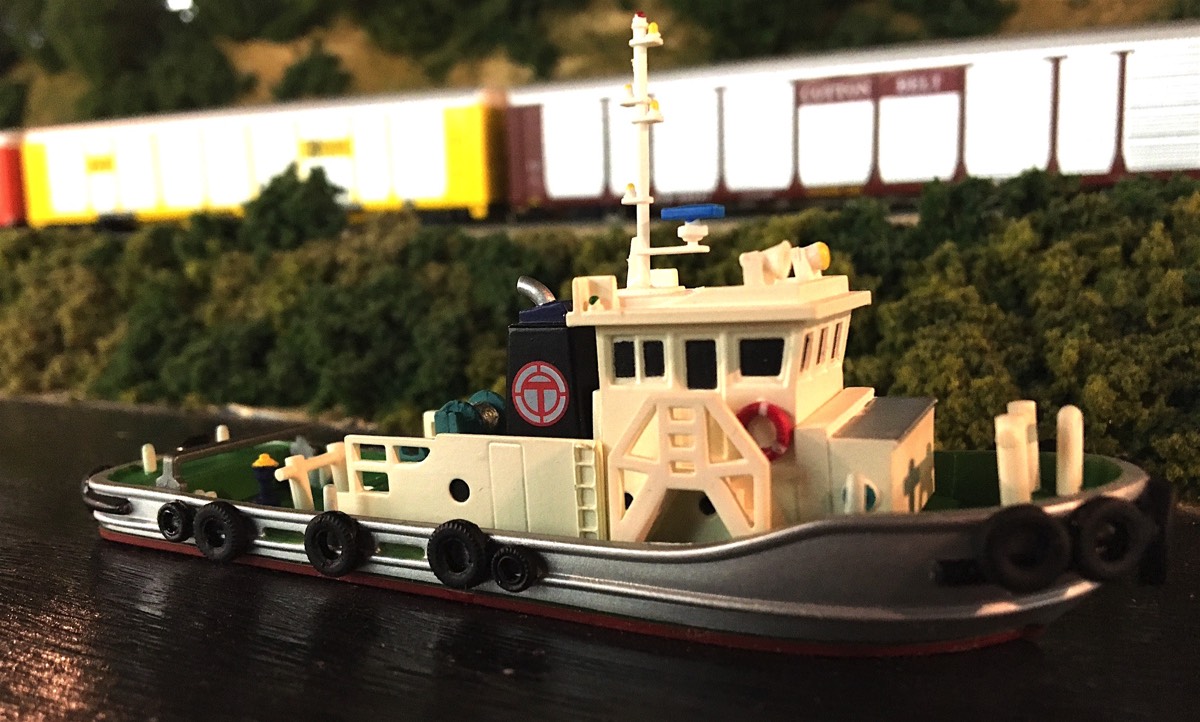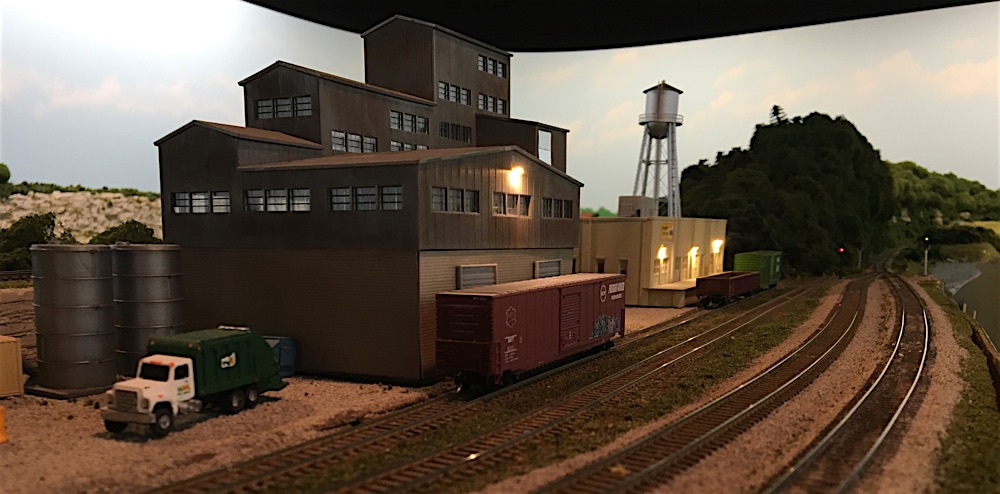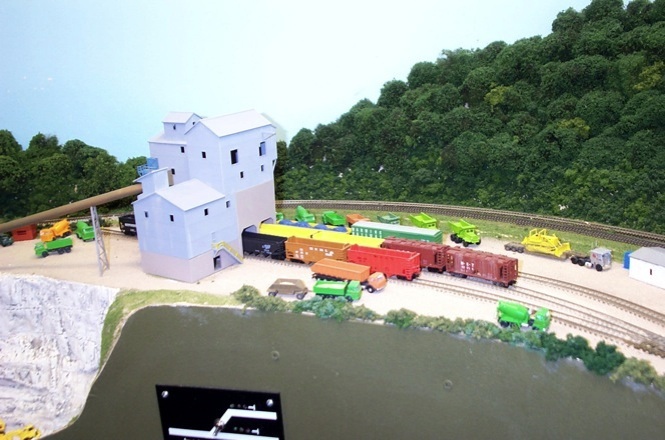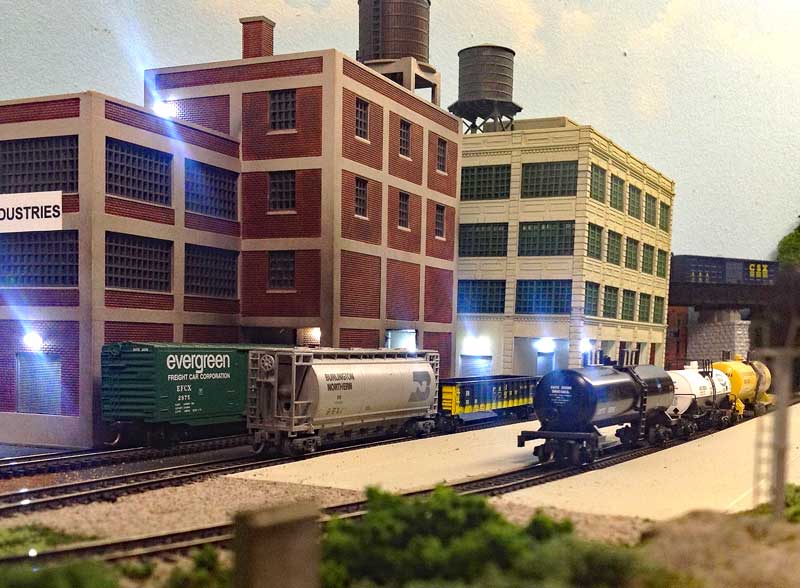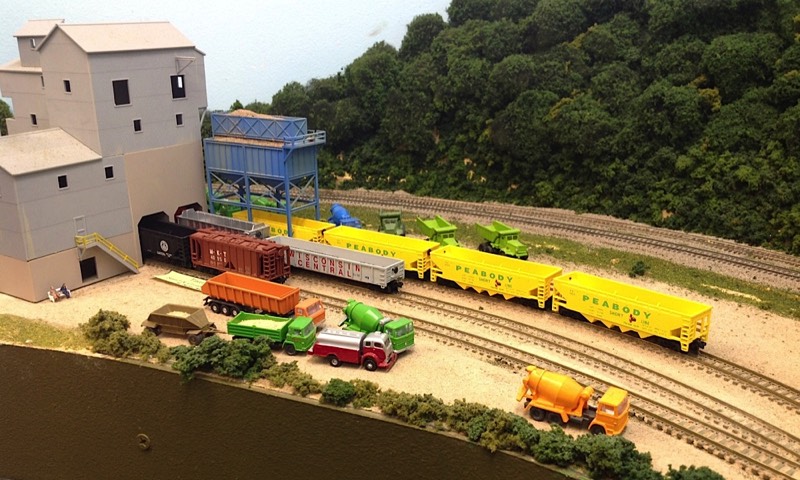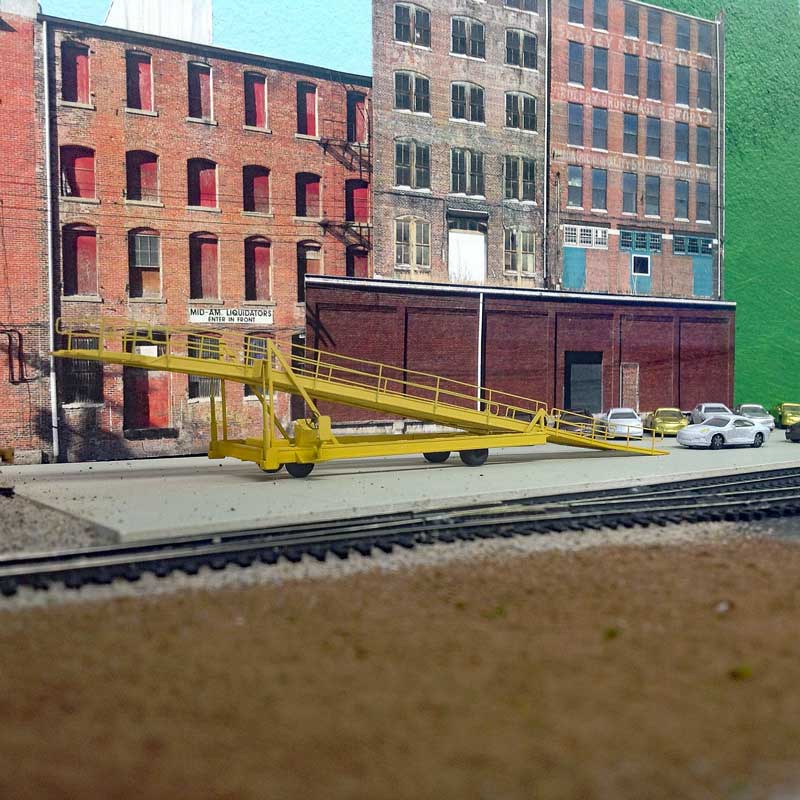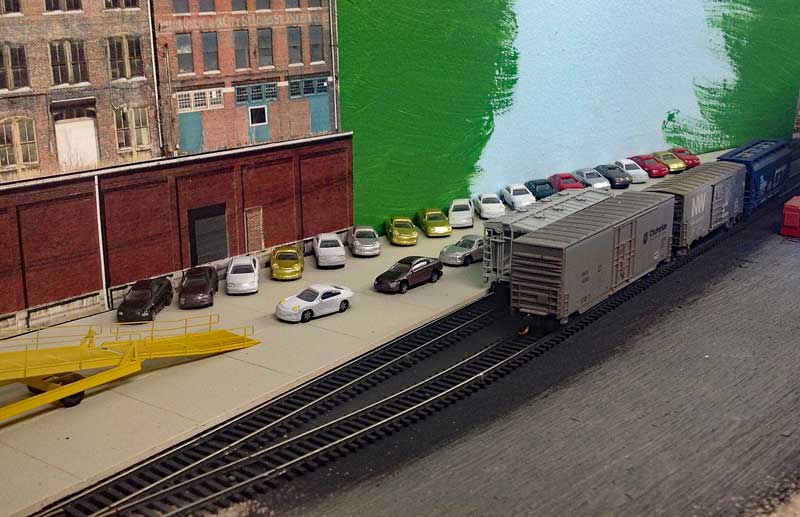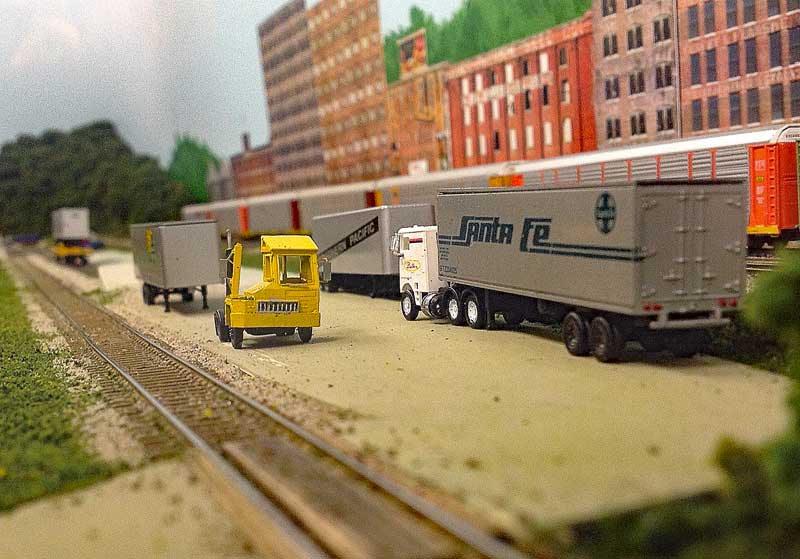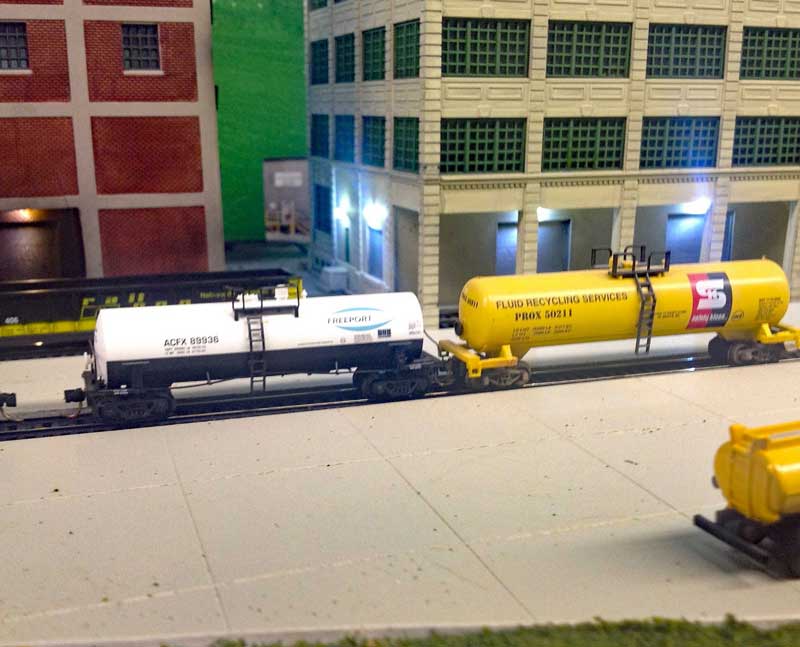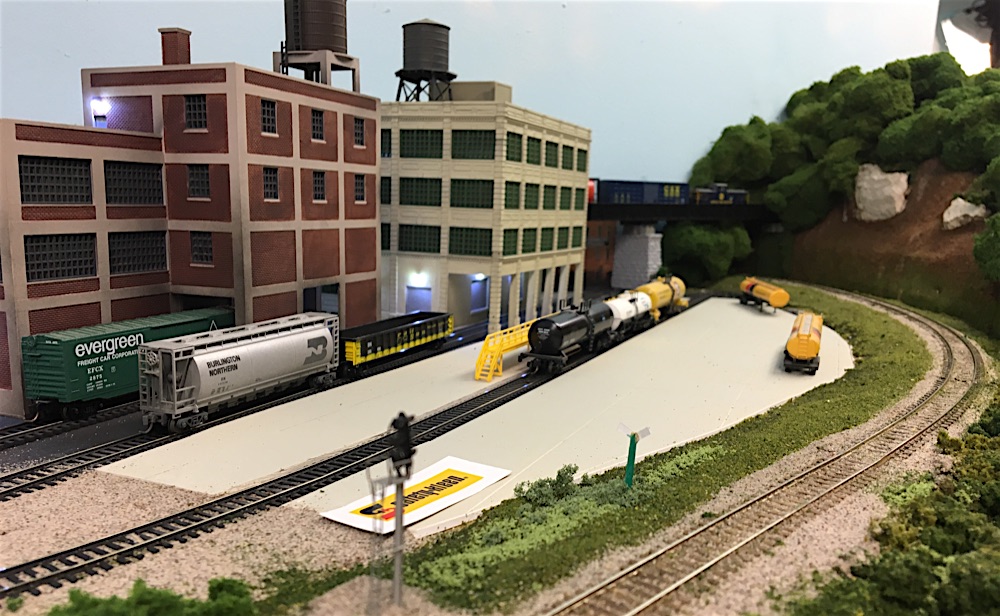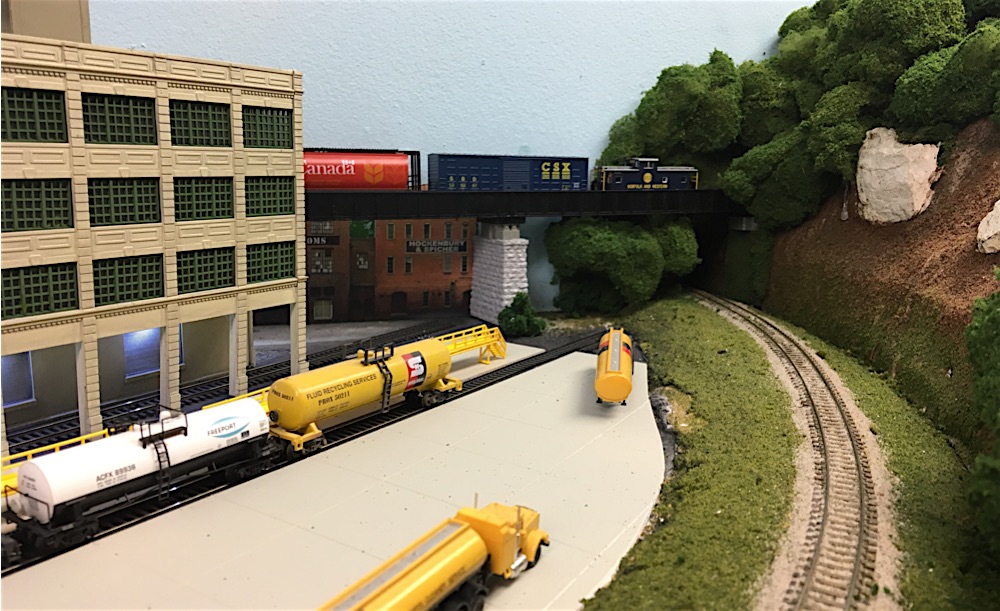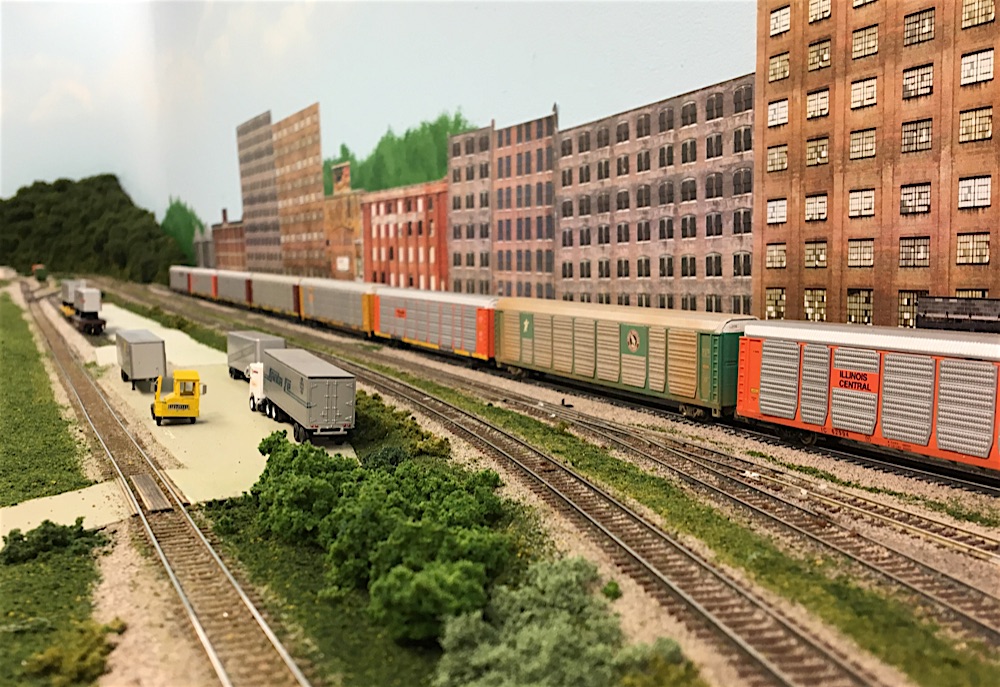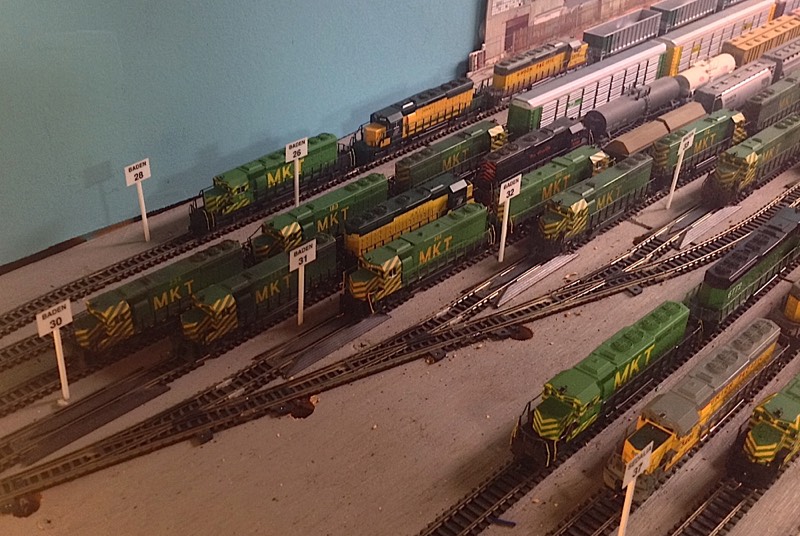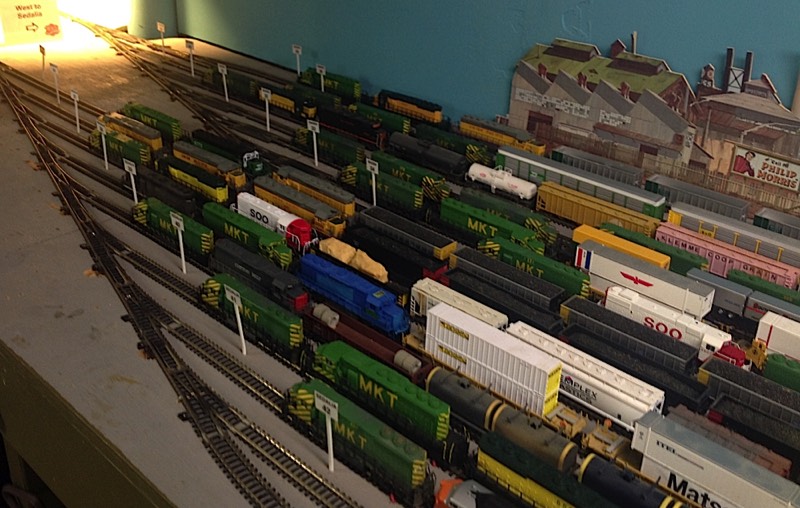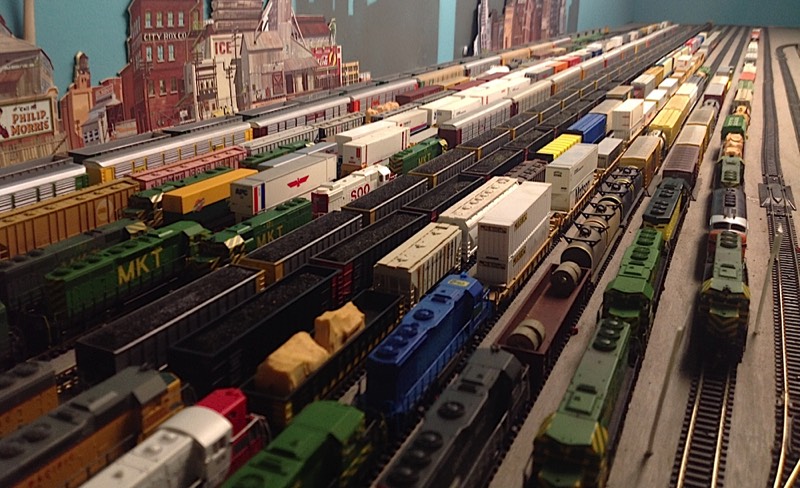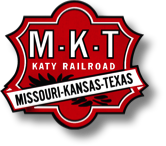Geographical Overview

The MKT railroad ran from Galveston, Texas and San Antonio, through Dallas and Fort Worth then north through Oklahoma. A big division point was at Parsons, Kansas, where the MKT split, one Division going directly north to Kansas City (via trackage rights on the BN) and even further north to Lincoln, Nebraska and Council Bluffs, Iowa (via trackage rights on the MP/UP).
Another MKT Division ran from Parsons to St. Louis, Missouri, crossing the Missouri River at Boonville, Missouri. This Northern Division ran on track just north of the river to St. Charles, Missouri. At St. Charles, the MKT track angled north to meet up with the old CB&Q line at Machens Junction. The MKT track ended at Machens, and the MKT trains continued over CB&Q/BN track to the terminal MKT yard at Baden, Missouri.
The northernmost portion of this Northern Division, from Sedalia to Baden Yard, was called the “St. Louis Subdivision”, and is the portion modeled on this layout.
A good historical overview of the MKT (although with a Texas emphasis) can be found here.
Another MKT Division ran from Parsons to St. Louis, Missouri, crossing the Missouri River at Boonville, Missouri. This Northern Division ran on track just north of the river to St. Charles, Missouri. At St. Charles, the MKT track angled north to meet up with the old CB&Q line at Machens Junction. The MKT track ended at Machens, and the MKT trains continued over CB&Q/BN track to the terminal MKT yard at Baden, Missouri.
The northernmost portion of this Northern Division, from Sedalia to Baden Yard, was called the “St. Louis Subdivision”, and is the portion modeled on this layout.
A good historical overview of the MKT (although with a Texas emphasis) can be found here.
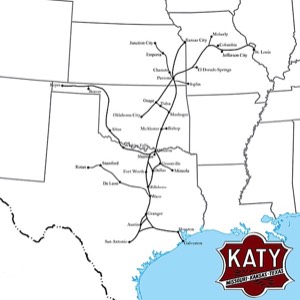
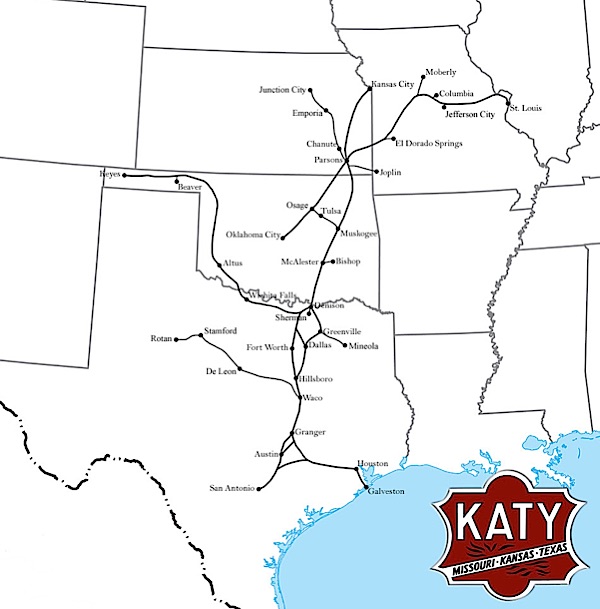
click to embiggen
Photo-annotated Layout Diagram
Click or tap a location to bring up picture
Summary of Locations on the Layout
Sedalia - West End Staging
The west end staging is located in a separate room from the main train room. The ten track single-ended set of tracks contain eastbound trains, originating from Dallas, Houston, and the big classification yard at Parsons, Kansas.
Although these track are called “Sedalia” tracks, the town of Sedalia is not modeled on the layout; the name Sedalia is just representative of off-layout destinations tp the west of the modeled portion of the railroad.
Staging turnout are controlled via the computer dispatching panel and also by operator-controlled panels at the staging fascia.
During an operating session, the dispatcher selected the staging tracks in and out of the staging yard. A pair of LED signals located in the train room can be used to monitor the progress of the train a it enters the staging room. Slow and rapid blinking aspect tell the operator that the train is approaching and then straddling the staging ladder. The LED goes solid red when the train is fully in the staging track and clear of the ladder.
The west end staging is located in a separate room from the main train room. The ten track single-ended set of tracks contain eastbound trains, originating from Dallas, Houston, and the big classification yard at Parsons, Kansas.
Although these track are called “Sedalia” tracks, the town of Sedalia is not modeled on the layout; the name Sedalia is just representative of off-layout destinations tp the west of the modeled portion of the railroad.
Staging turnout are controlled via the computer dispatching panel and also by operator-controlled panels at the staging fascia.
During an operating session, the dispatcher selected the staging tracks in and out of the staging yard. A pair of LED signals located in the train room can be used to monitor the progress of the train a it enters the staging room. Slow and rapid blinking aspect tell the operator that the train is approaching and then straddling the staging ladder. The LED goes solid red when the train is fully in the staging track and clear of the ladder.
Boonville
Boonville is the first town on the visible portion of the layout east from Sedalia Staging. The MKT interchanges with the UP/MP at Boonville, and there are several industries to switch in town.
The UP switching job is popular with rail fans operating on the MKT, St. Louis Subdivision, as you can switch cars AND watch the trains go by at the same time! On the prototype, the grade out of the Missouri River valley south out of Boonville was the ruling grade on the entire MKT system.
Boonville is the first town on the visible portion of the layout east from Sedalia Staging. The MKT interchanges with the UP/MP at Boonville, and there are several industries to switch in town.
The UP switching job is popular with rail fans operating on the MKT, St. Louis Subdivision, as you can switch cars AND watch the trains go by at the same time! On the prototype, the grade out of the Missouri River valley south out of Boonville was the ruling grade on the entire MKT system.
Missouri River Bridge
The Missouri River Bridge is a scenic element on the MKT, St. Louis Subdivision. Used to provide a lift-up opening across the door to the train room, the prototype bridge at Boonville was a lift span across the Missouri River.
The Missouri River Bridge is a scenic element on the MKT, St. Louis Subdivision. Used to provide a lift-up opening across the door to the train room, the prototype bridge at Boonville was a lift span across the Missouri River.
Franklin Yard
In the steam era, Franklin Yard served as a division point and helper district for for the long grade south out of the Missouri River valley (the ruling grade on the entire MKT system). In 1984 on the St. Louis Subdivision, Franklin Yard is a busy classification yard, receiving cars for distribution on the visible portion of the railroad and for destinations east and west. A diesel servicing facility is located at FY, and many through trains will have their locomotives refueled at this location.
In the steam era, Franklin Yard served as a division point and helper district for for the long grade south out of the Missouri River valley (the ruling grade on the entire MKT system). In 1984 on the St. Louis Subdivision, Franklin Yard is a busy classification yard, receiving cars for distribution on the visible portion of the railroad and for destinations east and west. A diesel servicing facility is located at FY, and many through trains will have their locomotives refueled at this location.
New Franklin
Originally established in 1828 after a flood destroyed the original town of Franklin, New Franklin has enjoyed an historic and colorful history. This area was the official beginning of the Sante Fe Trail and is the site of the Hickman House, the oldest known brick structure west of the Mississippi River. The St. Louis Sub serves the local industries here, including the bustling New Franklin Industrial Park, with its mix of contemporary and traditional industrial clientele. New Franklin is also the site of the Yellow Dog Cafe, where MKT trainmen grabbed many a greasy sandwich for the journey to St. Louis.
Originally established in 1828 after a flood destroyed the original town of Franklin, New Franklin has enjoyed an historic and colorful history. This area was the official beginning of the Sante Fe Trail and is the site of the Hickman House, the oldest known brick structure west of the Mississippi River. The St. Louis Sub serves the local industries here, including the bustling New Franklin Industrial Park, with its mix of contemporary and traditional industrial clientele. New Franklin is also the site of the Yellow Dog Cafe, where MKT trainmen grabbed many a greasy sandwich for the journey to St. Louis.
Westinghouse (North Jefferson)
North Jefferson is located just across the river from Missouri's State Capital, Jefferson City. North Jefferson is noted as the location of North End's largest customer, Westinghouse.
Maker of large commercial and custom transformers, Westinghouse is a prized client of the MKT, and warrants its own regular local train out of Franklin Yard. Shipments of inbound coil steel and outbound transformers can be seen regularly at Westinghouse.
North Jefferson is located just across the river from Missouri's State Capital, Jefferson City. North Jefferson is noted as the location of North End's largest customer, Westinghouse.
Maker of large commercial and custom transformers, Westinghouse is a prized client of the MKT, and warrants its own regular local train out of Franklin Yard. Shipments of inbound coil steel and outbound transformers can be seen regularly at Westinghouse.
Columbia Branch
Columbia is served by a branch line off the main, called the "Nine-mile" because it was nine miles long. The Columbia Branch climbs gently out of the Missouri River valley along Perche Creek to the bustling college community. The MKT serves several industries at Columbia, including the big Philips Lighting Plant and the power plant for the University of Missouri.
Columbia is served by a branch line off the main, called the "Nine-mile" because it was nine miles long. The Columbia Branch climbs gently out of the Missouri River valley along Perche Creek to the bustling college community. The MKT serves several industries at Columbia, including the big Philips Lighting Plant and the power plant for the University of Missouri.
Mokane
Mokane is a small farming community located just east of the branch line to Columbia. Basically just a siding with a few industries, many westbound trains are held at Mokane awaiting permission to enter Franklin Yard. Mokane derives its name from the original railroad that established the town, the Missouri, Kansas & Eastern, or MK&E. Mokane is correctly pronounced “mo-KANE-ey", but most railroaders use the more intuitive "MO-kane".
Mokane is a small farming community located just east of the branch line to Columbia. Basically just a siding with a few industries, many westbound trains are held at Mokane awaiting permission to enter Franklin Yard. Mokane derives its name from the original railroad that established the town, the Missouri, Kansas & Eastern, or MK&E. Mokane is correctly pronounced “mo-KANE-ey", but most railroaders use the more intuitive "MO-kane".
Rhineland
Rhineland lies in the lush wine country of Missouri's "Rhine Valley". The town was founded by German emigrants who dreamed of a New World utopia that would be "German in every particular." Rhineland now boasts a Bunge soybean processing plant, a Yuasa Battery manufacturing facility, and several long-time local industries that have been served by the MKT for decades.
Rhineland lies in the lush wine country of Missouri's "Rhine Valley". The town was founded by German emigrants who dreamed of a New World utopia that would be "German in every particular." Rhineland now boasts a Bunge soybean processing plant, a Yuasa Battery manufacturing facility, and several long-time local industries that have been served by the MKT for decades.
St. Charles
St. Charles, now a bedroom community for St. Louis, has grown with the MKT since the late 1800, when the Missouri, Kansas, and Eastern was built from St. Louis west. The MK&E trackage eventually became the St. Louis Subdivision of the MKT. Several industries are served by the Katy at St. Charles, most notably the Tavern Rock Sand and Gravel Company. Noted for its vein of ultra pure silica sand, Tavern Rock was busy in the late 1950s and early '60s providing silica for missile nose cones. Tavern Rock is busy today providing sand for all the major glass makers in the US and Canada.
Other major industries at St. Charles include the the piggy back trailer-on-flat-car ramp, an auto rack facility, the ACF Rail Car repair facility and the interchange with the Norfolk Southern.
St. Charles, now a bedroom community for St. Louis, has grown with the MKT since the late 1800, when the Missouri, Kansas, and Eastern was built from St. Louis west. The MK&E trackage eventually became the St. Louis Subdivision of the MKT. Several industries are served by the Katy at St. Charles, most notably the Tavern Rock Sand and Gravel Company. Noted for its vein of ultra pure silica sand, Tavern Rock was busy in the late 1950s and early '60s providing silica for missile nose cones. Tavern Rock is busy today providing sand for all the major glass makers in the US and Canada.
Other major industries at St. Charles include the the piggy back trailer-on-flat-car ramp, an auto rack facility, the ACF Rail Car repair facility and the interchange with the Norfolk Southern.
Baden Yard (East End Staging)
Baden Yard (East end staging) marks the end of the line for the MKT. Baden Yard was reached via CB&Q (later BN) trackage at Machens, and across the Bellfontaine Bridge to near downtown St. Louis just north of the St. Louis Arch. In years past, Katy passenger trains would continue to the St. Louis Union Station. As modeled on the St. Louis Sub, Baden is a terminal yard, and interchanges eastbound revenue cars with several railroads on both sides of the Mississippi River.
The St. Louis Terminal Railway Association (TRRA), partly owned by the MKT, provides interchange service between Baden and the other local railroad yards. Alas, the real Baden Yard is long gone…
Baden Yard (East end staging) marks the end of the line for the MKT. Baden Yard was reached via CB&Q (later BN) trackage at Machens, and across the Bellfontaine Bridge to near downtown St. Louis just north of the St. Louis Arch. In years past, Katy passenger trains would continue to the St. Louis Union Station. As modeled on the St. Louis Sub, Baden is a terminal yard, and interchanges eastbound revenue cars with several railroads on both sides of the Mississippi River.
The St. Louis Terminal Railway Association (TRRA), partly owned by the MKT, provides interchange service between Baden and the other local railroad yards. Alas, the real Baden Yard is long gone…
